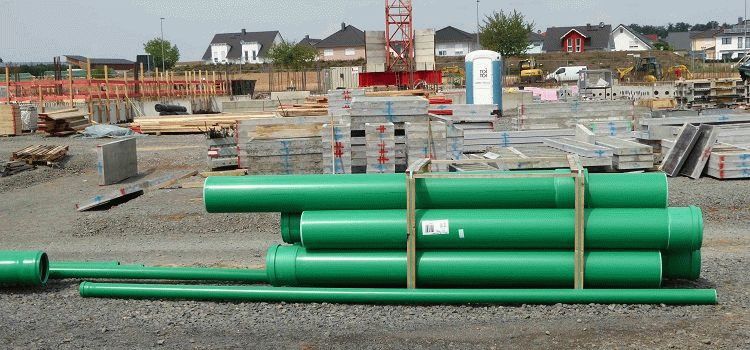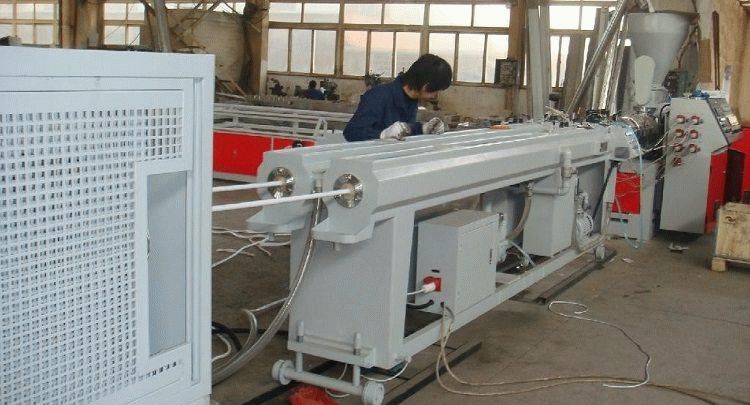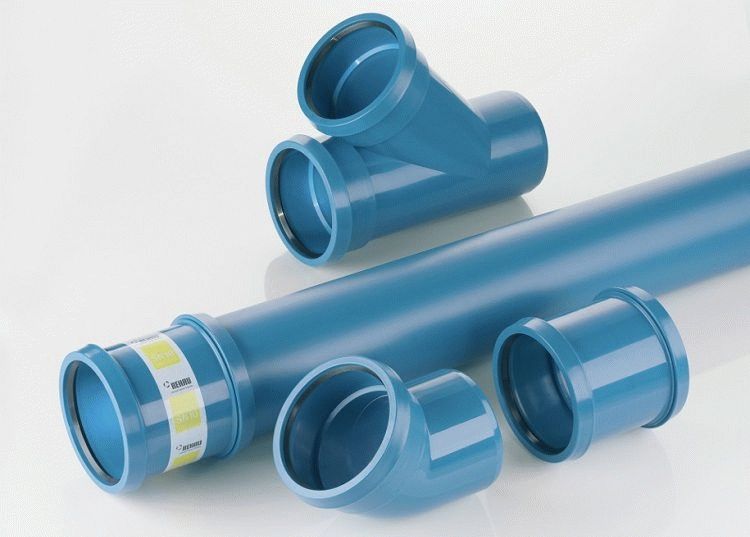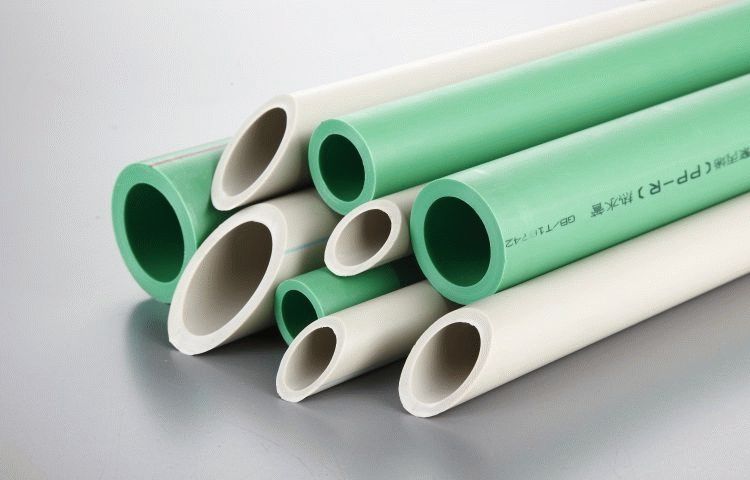
Polypropylene pipes GOST, see, requirements
Standardization is a fundamental factor in shaping product quality, produced by industry. Polymer communications are no exception. Their production is also regulated by GOST for polypropylene pipes, polyethylene, polyethylene and others). Regulatory documents reflect the basic requirements for products, their technical characteristics and parameters.

Polypropylene pipes come in a variety of types and sizes, but each of them is carried out according to GOST
Categories of polypropylene products
There are the following categories of products:
- PN10: have thin walls, designed for cold water supply temperatures up to 20 ° C (possible increase to 45 ° C) at pressure 1 thousand. kPa;
- PN20: universal, designed for hot pipelines with temperatures up to +80 ° C at pressure 2 thousand. kPa;
- PN25: reinforced with aluminum foil, designed for water supply, heating temperature to +95 ° C at pressure 2500 kPa;
- polypropylene sewer communications and fittings;
- pipes, reinforced with fiberglass: applicable to all systems.
Polypropylene pipe is light in weight with high strength, maximum ease of installation, for which special fittings are used, surface smoothness, excellent hydraulic properties, resistance to mechanical loads. Reinforced communications are used in networks with very high temperatures.
GOST for polypropylene pipes for heating and water supply
Qualitative indicators and scope of polypropylene pipe are reflected in several regulations (GUEST ). The main one is GOST R 52134, which came into force in 2003 year.

Observance of Guests is necessary at production of pipes, necessary, the quality and characteristics of products depend on it
pay attention! The standard regulates the quality and defines the basic parameters of the pipe, made of various thermoplastic materials. in addition, the document contains requirements for fasteners and fittings, used in heating and water supply networks.
GOST applies to communications made of polyethylene (RE, PE), polyvinyl chloride (unplasticized NPVH and chlorinated HPVH), polybutene (RV, PB), cross-linked polyethylene (PE-S, RE-H), and polypropylene with its copolymers:
- homopolymer (Cyrillic / Latin: PP-R / RR-N);
- block copolymer (Latin / Cyrillic: RR-V / PP-B);
- random copolymer (Cyrillic / Latin: PP-R / RR-R).
The dimensions of the pipe are set in GOST, as well as indicators, which determine their service life. These include:
- long lasting strength;
- values of temperature and pressure;
- margin of safety in the coefficient representation.
The document contains a method of calculating the minimum value of the wall thickness of the product based on the long-term strength of the material and operating conditions. Methods of product testing are presented to guests on polypropylene pipes for water supply networks and heating systems, which allow them to be evaluated.
Polypropylene pipe for sewerage: GUEST
There is GOST for sewer communications and fittings 32414 from 2013 year. According to the standard,the maximum increase in the average outer diameter compared to the nominal for pipes with a diameter of 32 to 63 mm is 0,3 mm, from 75 to 125 – 0,4 mm, 160 mm - 0,5 mm, 200 mm - 0,6 mm.

Sewer pipes also differ in wall thickness and diameter, the higher the load on the system - the greater these parameters should be
GOST sets ranges of values of average wall thickness for pipes of different nominal diameter. So, for products with a diameter 32-50 mm this value varies from 1,8 to 2,2 mm (sewer pipes series 16 S and S 20), for other pipes the parameters are given in the table.
Table 1
| For the S series 16, *10-1 mm | Diameter | For the S series 20, *10-1 mm |
| 20-24 | 63 mm | 18-22 |
| 23-28 | 75 mm | 19-23 |
| 25-30 | 80 mm | 20-24 |
| 28-33 | 90 mm | 22-27 |
| 32-38 | 100 mm | 25-30 |
| 34-40 | 110 mm | 27-32 |
| 39-45 | 125 mm | 31-37 |
| 49-56 | 160 mm | 39-45 |
| 62-71 | 200 mm | 49-56 |
If polypropylene products for sewer networks are chamfered, then its angle should be 15-45 degrees to the axis of the pipe. The maximum deviation of the length of communications to a greater or lesser extent is not more 10 mm.
Requirements for polypropylene products according to GOST R 52134
According to GOST on polypropylene pipes for heating or water supply to products there are such general requirements:
- round cross section;
- attribution to the pressure type;
- application in production, in residential and non-residential buildings;
- possibility of transportation of the heat carrier, technical and drinking water.
in addition, and external, and the inner surface of the pipe should be perfectly smooth with the typical presence of longitudinal stripes and waves, which do not affect the overall diameter. It is also necessary, that coloring of communications of water supply or heating was uniform without extraneous inclusions, smug, divorces and cracks. The color of communications is specified in the regulatory document for the product.
pay attention! According to Gost, polypropylene pipes can be produced with diameters 1-160 div.

The appearance of the pipes and even their color must correspond to the DST
If the outer diameter is up to 16 cm, then they are delivered in bays, wound on a spool or in the form of straight segments. Pipes with a diameter 18 cm and above are available in straight sections up to 24 meters.
Dimensions of water pipes
GOST for polypropylene communications for water supply (heating) contains requirements for their wall thicknesses. The values depend on the size ratio and the series of pipes. Change in nominal thickness, starting with ? 2,1 and ending with the value ? 61,1, happens in steps 1,0. The step of increasing the value of the maximum deviation for the wall thickness of the products is 0,1, starting with 0,5. For nominal wall thickness ? 1,0 the maximum deviation is 0,4.
During the tests, water pipes are kept at least 2 hours at room temperature 23 ° C (with a permissible deviation in one direction or another 5 ° C). The value of the average outer diameter is determined at a distance of at least 10 cm from the pipe end of the product with an error of not more 0,05 mm. Let us define this parameter as the arithmetic mean of the four measurements, which are evenly distributed around the circumference of the pipe in one section and rounded to 0,1 mm
Ovality of polypropylene pipe communications (GUEST 52134) is set as the subtraction of the minimum value of the outer diameter of the cross section of communications from the maximum. The wall thickness is at a distance of at least 1 cm from the end in a single cross section at six points, which are evenly distributed on it. The error is no more 0,05 mm
An important parameter for polypropylene water pipes is the thickness of their walls, which must correspond to the type and diameter of the product
Testing of pipes and fittings
Check of stability of a pipe at constant internal pressure is carried out under conditions, presented in the table.
Table 2
| Temperature in ° С | twenty | Ninety-five | ||
| Polypropylene pipe of a certain type | The initial voltage in the pipe wall in MPa | |||
| RR-R | Sixteen | 4,2 | 3,8 | 3,5 |
| RR-V | Sixteen | 3,4 | 3,0 | 2,6 |
| RR-N | Twenty one | 5,0 | 4,2 | 3,5 |
| Test time, year | no less 1 | no less 22 | no less 165 | no less 1000 |
Thermal stability at temperature 110 ° C and is 8760 hours at the values of the initial voltage in the wall:
- for PP-R: 1,9 MPa;
- for RR-B: 1,4 MPa;
- for RR-N: 1,95 Kg.
The change in the length of communications during heating should not exceed 2%. The tests are performed under conditions, specified in table №2.
Table 3
| Product type | Temperature in ° С | Time in minutes | Wall thickness in millimeters |
| RR-H and RR-B | 150 (deviation ± 2) | 240 (deviation ± 5) | more 16 |
| 120 (deviation ± 2) | 8-16 | ||
| RR-R | 135 (deviation ± 2) | ||
| 60 (deviation ± 2) | Less 8 |
The standard sets the value of the relative elongation at break, which for polypropylene products of all types is not less 200%.
pay attention! The change in the PTR of the pipes in comparison with a similar value of the source material should not be more 30%, opacity - less 0,2%.
Types and sizes of fittings for connection of PP-pipes are also determined by GOST
According to Gost, polypropylene fittings come in several types. In the General case, the polymer elements are divided into compression, press, flanged, threaded (with the presence of elastic seals).
Technical requirements for sewer communications according to GOST
Polypropylene pipe (sewer) behind the document 32414 must have characteristics, which are shown in the table.
Table 4
| Indicator | Unit | Value |
| Impact strength (for PP at temperature 0 ° C, for PP-H - 23 ° C) | SHOOT?10% | SHOOT ? 10% |
| Impact strength for polypropylene copolymer at 0 ° C (step method) | H50?1 m (not more 1 destruction when the load falls from a height ?50m) | H50 ? 1 m (not more 1 destruction when the load falls from a height ? 50 cm) |
| Impact strength (according to Charpy) | not more 10 | % |
| Changing the length of communications for the sewer after heating | not more 2 | % |
| Change in PTR - melt flow index | not more 0,2 | d / 10 min |
Fittings and other fittings must provide a watertight connection without leakage under pressure 0,5 MPa for a quarter of an hour, at 0,1 MPa - for 5 minutes. Checking of products is also carried out at cyclic action of the raised values of temperature. So, deflection of communications for the sewerage with a diameter ? 50 millimeters should be no more 3 mm, and for the pipe > 50 millimeters - no more 5% from the diameter of the product.
Tests of polypropylene pipes are carried out in conditions, specified in regulatory documents
Parameter parameters in accordance with the standard
GUEST 32414 determines the requirements for the size of fittings for sewerage. These include:
- challenge (bell-bell, trumpet end-bell, bent with a certain radius and welded from segments of pipe);
- tee (bell-bell-bell, pipe end-bell-bell, bent with a certain radius);
- cross-piece (ordinary, biplane);
- transition pipe;
- clutch (dry, two-trumpet);
- audits;
- butt for butt welding;
- plug.
The angles of the elements for the sewer can correspond to the values in table №4.
Table 5
| Angle | Challenge | Tee | Cross-piece |
| 87,5-90° | + | + | + |
| 67,5° | + | + | + |
| 45° | + | + | + |
| 30° | + | — | — |
| 22,5° | + | — | — |
| 15° | + | — | — |
The document assumes a decrease in the value of the wall thickness of the pipe end or housing to 5% with the condition, that the arithmetic mean of these parameters for opposite walls is not less than the values, listed in GOST.
Sewer fittings must exactly match the size of the connecting pipes, that joints were tight
pay attention! Transitional fittings are designed for joining pipelines of different sizes. In this case, a smooth change in wall thickness is constructively assumed.
For prefabricated fittings, except for bells and pipe ends, this change may be local in nature and be performed in the manufacture of the product.
Marking and requirements for raw materials for sewage products
Shaped elements, pipes and fittings are made of polypropylene block copolymer or homopolymer polypropylene with the inclusion of additives (stabilizers, pigments). The value of PTR at 230 ° C / 2.16 kg should be less 3,0 d / 10 min.
The material of shaped elements and pipes for butt welding is subject to classification according to PTR:
- Melt fluidity ? 0,1 d / 10 min - class A;
- From 0,3 d / 10 min to 0,6 d / 10 min - class B;
- From 0,6 d / 10 min to 0,9 d / 10 min - class C;
- From 0,9 d / 10 min to 1,5 d / 10 min - class D.
Sewage pipes and shaped elements are subject to butt welding, belonging to one or the neighboring class of PTR. During production addition of material is allowed, recyclable. Rubber is used to make sealing rings.
Pipes and fittings are marked on the outside. If the method of thermal embossing is used for this purpose, then the depth of indentation is limited in 0,25 mm Marking of sewer pipes is carried out with an interval 1 meter and less. It contains information about the manufacturer (trademark or name, symbol of the product and date of manufacture.
The necessary information is applied to the outside of the pipe using special equipment
If the communications are at least one meter long, then they can be labeled with stickers. On products for butt welding the class from PTR is given.
Reinforced communications for heating
When installing heating, special attention should be paid to reinforced polypropylene pipes. GOST R 52134 determines the thickness of the products, which leads to the need to optimize the content of additives (when reinforcing with fiberglass). To do this, you must take into account, that the fiber of the inner layer should not violate hygienic standards and do not impair the reliability of the welding joint.
pay attention! Communications, reinforced with fiberglass, differ in monolithicity, low thermal expansion and high rigidity, which allows their use with smaller diameters.
The use of aluminum foil can be done in several ways:
- placement in the middle of the pipe wall;
- placement near the outer surface and gluing;
- the use of perforated foil in the middle of the pipe wall.
The latter method allows to obtain a monolithic connection with the polymer, which improves the parameters of the finished product. When using non-perforated foil, the structure has a multilayer structure.
Polypropylene communications are an excellent alternative to metal due to their high strength and performance characteristics. The use of pipe reinforcement gives qualities, which allow to include them effectively in heating pipelines.


